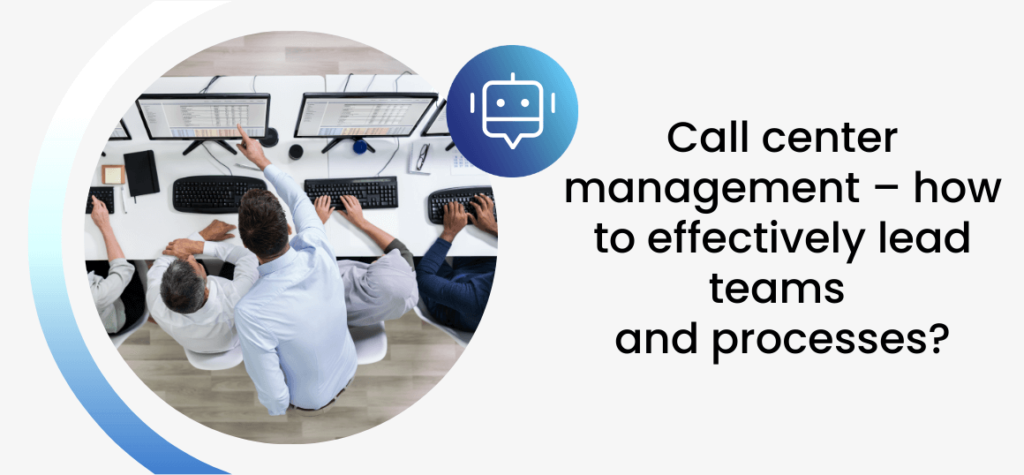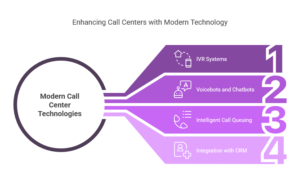Call center management – how to effectively lead teams and processes?

From chaos to control: effective call center management and efficient resource utilization
A call center is the heart of customer service in many companies, and managing it is one of the biggest operational challenges. It requires not only organizational skills but also strategic thinking, excellent communication, and flexibility in action. A call center manager must simultaneously ensure team motivation, service quality, and the achievement of business goals—often in a fast-paced environment with high turnover and strong performance pressure.
In this article, we present the key areas of effective call center management—from setting goals and KPIs, through team building, to implementing changes and automation. Interested? Keep reading.
Team work organization – the foundation of an efficient call center
Effective work organization in a call center is not just about recruitment, scheduling, or headcount per shift. It’s primarily about the ability to plan structures, roles, and task flows in such a way as to provide customers with fast and competent service, and employees with clear expectations and comfortable working conditions.
Operational structure and team roles
The first step in team management is defining clear roles and assigning responsibilities. A typical call center consists of various position levels:
- First-line consultants – usually handle simple inquiries and routine matters;
- Second-line specialists – deal with more complex issues or those requiring expert knowledge;
- Technical or sales support teams – work alongside consultants but with different operational goals;
- Coordinators and team leaders – monitor quality, performance, and support team development.
It is crucial that each team member knows their responsibilities, and that the case handover system is transparent and fast (e.g., through CRM system integration).

Optimal workforce planning (workforce management)
Call center managers should implement Workforce Management (WFM) – an approach focused on forecasting team workload and scheduling based on historical data and seasonality. Effective work organization takes into account:
- the number of phone calls and tickets per day/week/month;
- Average Handling Time (AHT);
- consultant availability (not just full-time positions, but also vacations, sick leave, and turnover);
- flexible shifts (e.g., shorter during peak hours, longer during quieter periods).
Modern call center tools – such as those offered by EasyCall Contact Center – also include real-time traffic reports and analytics, making it easier to adjust the number of active agents to current demand.
Defining and monitoring performance metrics – the foundation of contact center optimization
Managing a call center without clearly defined Key Performance Indicators (KPIs) is like steering a ship without a compass. KPIs not only show how the team performs day-to-day but also help assess process effectiveness, identify areas for improvement, and support data-driven decision-making. Well-chosen KPIs are the cornerstone of both operational and strategic management.
Below are the most important KPIs that every call center manager should know, understand, and regularly analyze:
- AHT (Average Handling Time) – the average time spent handling a customer inquiry. A high AHT may indicate inefficiency, while a low one might signal a superficial service. It should be analyzed in the context of issue resolution quality and call types;
- Service Level (SL) – the percentage of calls answered within a specified time (e.g., 80% within 20 seconds). This metric reflects team availability and the level of service expected by customers;
- ASA (Average Speed of Answer) – the average time a customer waits before speaking to an agent. It directly affects customer satisfaction and the risk of call abandonment;
- Abandonment Rate – the percentage of calls dropped by customers before reaching an agent. A high rate is a sign that the team is struggling to keep up and that organizational changes or automation may be necessary;
- FCR (First Contact Resolution) – the percentage of issues resolved during the first contact. The higher the FCR, the better the team’s effectiveness and the lower the operational costs;
- CSAT (Customer Satisfaction Score) – the result of a post-call customer satisfaction survey. Though subjective, it’s a crucial measure of Customer Experience (CX);
- Agent Occupancy Rate – the percentage of time an agent spends actively handling calls and related tasks, compared to total working time. A very high occupancy rate can lead to burnout, while a low one may indicate inefficiency.
Service quality and skill development – how to build a professional team and high customer experience standards
A well-managed contact center is one where every team member knows how, why, and for what purpose they are speaking with the customer. The manager’s role goes beyond monitoring performance—it includes actively developing employee skills, implementing quality standards, and creating an environment that fosters continuous improvement.
So, what exactly is “customer service quality” in a call center? It’s a combination of many elements that together create a cohesive and professional customer experience. The ability to understand a customer’s problem and resolve it effectively in the shortest possible time is key. Equally important is the way the conversation is conducted—professional language, appropriate tone of voice, empathy, and active listening all directly impact how the interaction is perceived.
Substantive knowledge is also crucial: a consultant must be well-versed in the company’s offerings, procedures, and capable of efficiently using internal systems. Additionally, high-quality service means providing complete and accurate information in line with the company’s standards. All of this translates into customer satisfaction, brand loyalty, and the perceived credibility of the organization.
How to develop team competencies in practice?
To ensure a high level of service, a call center manager should implement a structured, multi-stage employee development model that includes:
- Onboarding and training for new consultants
New employees should go through a clearly defined onboarding process that covers knowledge about the company, its products, systems, and communication standards. Practical exercises, call simulations, and knowledge tests are essential components of this initial phase;
- Ongoing and refresher training
The dynamic nature of the market, services, and customer expectations requires constant skill development. Training should cover not only the product/service offering but also topics like stress management, handling difficult conversations, or using new tools (e.g., working with a voicebot or CRM system);
- 1:1 Coaching and feedback
Regular analysis of call recordings (available, for example, in EasyCall systems) helps identify both mistakes and best practices. Managers should review specific cases with employees, provide constructive feedback, and set clear development goals together;
- Internal benchmarking and knowledge sharing
A valuable practice is to organize team meetings where top-performing consultants share effective techniques or where challenging customer cases are discussed. This fosters a culture of learning and mutual support;
- Quality assurance system
It is essential to establish clear criteria for evaluating calls—ideally based on a competency matrix or a quality assessment form. Based on this, internal or external auditors can conduct random call reviews and provide objective evaluations.
Working in a call center and modern systems – which technologies should be implemented to benefit both consultants and customers?
Modern call center systems enable the automation of many processes, enhance efficiency and service quality, and relieve employees from repetitive tasks.
In practice, this includes:
- IVR systems (Interactive Voice Response) that direct customers to the right department or provide automated responses;
- Voicebots and chatbots that handle simpler inquiries without the need for an agent;
- Intelligent call queuing, which reduces waiting times;
- Integration with external systems, such as CRM, enabling quick access to customer history and better personalization of conversations.
However, managers should remember that implementing technology is not just about purchasing a system. Equally important are its proper configuration, regular data analysis, and continuous improvement of automated call scenarios so that they support real business objectives.

Change management and process improvement – the key to long-term efficiency
In a call center environment, change is the norm—customer needs evolve, internal procedures shift, new technologies emerge, and work models change (e.g., hybrid or remote work). Each of these changes can create resistance, stress, and temporary dips in productivity. The manager’s role is to guide the team through these transitions in a structured and mindful way.
But what about process reorganization? How can performance and service quality be continually improved? Optimization is not a one-time action—it’s a continuous effort to refine everyday operations. It’s not just about cutting costs or shortening call durations—the goal is to strike a balance between efficiency and quality of service.
Key areas to regularly analyze:
- Customer contact paths – does the customer reach the right person in the shortest possible time?
- Call scripts – are they helpful or do they hinder the consultant? Do they sound natural?
- Work tools (CRM, call queue systems) – are they intuitive? Do they save or waste agents’ time?
- Internal processes – for example, complaint approvals or interdepartmental handoffs—are they logical and fast?
Optimization techniques used in call centers:
- Lean Management – Eliminating waste of time and resources, standardizing best practices;
- Data analysis and automation – Using CRM and analytics systems to identify recurring issues and automate their resolution;
- Internal benchmarking – Comparing performance across teams or shifts and drawing actionable insights.
Practical example:
Has your company noticed a rise in Average Handling Time (AHT), even though the number of inquiries hasn’t increased? The first steps should be to:
- review call recordings to identify the cause (e.g., excessively long customer data verification);
- consult agents—perhaps new challenges have emerged, such as a lack of up-to-date knowledge base;
- design a shorter verification process or update scripts accordingly.
Curious how EasyCall supports Polish companies? Discover the success story of our client, Omega Medical Clinics.
EasyCall – a new standard in contact center management
Managing a call center goes far beyond tracking KPIs and scheduling shifts. It’s a strategic function that directly impacts customer experience, brand reputation, and a company’s financial performance. An effective call center leader is not just a process manager—but a culture builder, responsible for people development, innovation, and the constant pursuit of better solutions.
At EasyCall, we believe that effective communication starts with the right partner. For over 15 years, we’ve operated as a licensed telecom provider and are part of the publicly listed SoftBlue S.A. group on the NewConnect market. We offer not just tools, but real, hands-on support for the implementation and growth of your contact center. Let’s talk about how we can help your business thrive. Book a free consultation today and discover what our experts can do for you.
